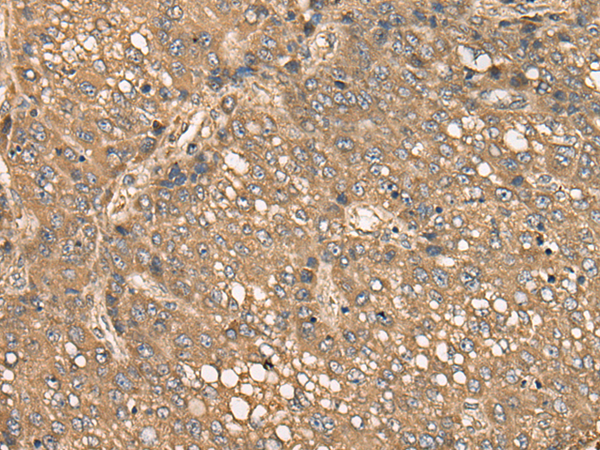
| WB | 咨询技术 | Human,Mouse,Rat |
| IF | 1/20 | Human,Mouse,Rat |
| IHC | 1/50-1/100 | Human,Mouse,Rat |
| ICC | 技术咨询 | Human,Mouse,Rat |
| FCM | 咨询技术 | Human,Mouse,Rat |
| Elisa | 咨询技术 | Human,Mouse,Rat |
| Aliases | C4BP |
| Host/Isotype | Rabbit IgG |
| Antibody Type | Primary antibody |
| Storage | Store at 4°C short term. Aliquot and store at -20°C long term. Avoid freeze/thaw cycles. |
| Species Reactivity | Human |
| Immunogen | Fusion protein of human C4BPB |
| Formulation | Purified antibody in PBS with 0.05% sodium azide and 50% glycerol. |
+ +
以下是关于SHP2抗体的3篇代表性文献及其摘要概述:
---
1. **文献名称**:*Allosteric inhibition of SHP2 phosphatase inhibits cancers driven by receptor tyrosine kinases*
**作者**:Chen, Y.N., et al.
**摘要**:该研究开发了一种变构SHP2抑制剂(如SHP099),通过结合SHP2的变构位点抑制其磷酸酶活性,从而阻断RAS/MAPK信号通路。实验表明该抑制剂可有效抑制RTK驱动的肿瘤生长,为靶向SHP2的癌症治疗提供了新策略。
2. **文献名称**:*Structural basis for phosphotyrosine recognition by the SHP2 SH2 domains*
**作者**:Barford, D., et al.
**摘要**:通过X射线晶体学解析了SHP2的SH2结构域与磷酸化酪氨酸肽段的复合物结构,揭示了SHP2识别信号蛋白的分子机制,为设计靶向SHP2的抗体或抑制剂提供了结构基础。
3. **文献名称**:*SHP2 blockade enhances anti-tumor immunity via tumor cell intrinsic and extrinsic mechanisms*
**作者**:Wang, J., et al.
**摘要**:研究发现SHP2抑制剂通过双重机制增强抗肿瘤免疫:一方面抑制肿瘤细胞内的MAPK信号,另一方面激活肿瘤微环境中的T细胞和NK细胞,显著提高免疫检查点疗法的疗效。
---
这些文献涵盖了SHP2的结构、功能及靶向治疗应用,可作为相关研究的参考。如需具体文章,建议通过PubMed或期刊官网检索标题或作者名获取全文。
SHP2 (Src homology 2 domain-containing protein tyrosine phosphatase-2), encoded by the *PTPN11* gene, is a non-receptor protein tyrosine phosphatase pivotal in regulating cell signaling pathways. It contains two N-terminal SH2 domains, a catalytic phosphatase domain, and a C-terminal tail. SHP2 plays a dual role in signal transduction: it activates the RAS/MAPK pathway to promote cell proliferation, differentiation, and survival, while also modulating immune responses and metabolic pathways. Dysregulation of SHP2. particularly gain-of-function mutations, is linked to developmental disorders like Noonan syndrome and cancers such as leukemia, neuroblastoma, and solid tumors.
Anti-SHP2 antibodies are essential tools for studying its expression, localization, and activity in both physiological and pathological contexts. They are widely used in techniques like Western blotting, immunohistochemistry, and immunoprecipitation to investigate SHP2's interactions with signaling molecules (e.g., growth factor receptors, adaptor proteins). Recent research focuses on SHP2's role in cancer immunotherapy resistance and tumor microenvironment remodeling, driving interest in therapeutic antibodies or inhibitors targeting SHP2. Notably, allosteric inhibitors like SHP099 are under clinical investigation, highlighting SHP2's potential as a drug target. These antibodies also aid in biomarker discovery and mechanistic studies of SHP2-related diseases.
×